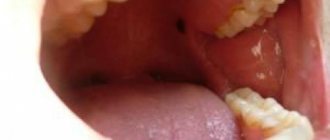At the end of the last century, malignant tumors of the oral cavity were considered a concomitant disease of wastrels due to the abuse of tobacco and alcohol. Today, experts also include the human papilloma virus among the causes of cancer in this localization, so the frequency of all head and neck tumors has increased significantly.
- What precedes cancer
- When should a malignant process be suspected?
- Stages of lip cancer
- How to treat
Head and neck cancer ranks sixth in the world among all malignant tumors and will soon be in the TOP-5, but, unlike its “brothers” in localization, the detection rate of lip cancer is not increasing, but is steadily decreasing.
The incidence of lip cancer has decreased by more than 16% over the past 5 years. In 2021, carcinoma was detected in 2,235 Russians, with men getting sick 2.7 times more often.
- Out of 100 thousand people, 29 Russians develop the disease, and at a more mature age than a decade ago.
- The average age of affected women is 75.5 years; in them, the tumor is often localized on the upper lip.
- In men, cancer is diagnosed on average 8 years earlier, in most cases on the lower lip.
- In 87.6%, the disease is detected at stages 1-2, stage 3 with metastases to the lymph nodes is diagnosed in 8%, and stage 4 in 4.6%.
What precedes cancer
The lips are muscles covered with tissue and skin, which is called the “red border”. The inner part, covered with the mucous membrane, anatomically belongs to the vestibule of the oral cavity, and tumors arising there are no longer considered labial. A malignant tumor of the lip can arise out of nowhere - practically out of nowhere, and since this disease is considered to belong to a not very socially prosperous population, cancer in this localization is often preceded by skin diseases of the red border of the lips. These pathological conditions are classified as precancerous, although not all of them become fertile ground for the development of a malignant process.
Precancerous processes are similar in appearance, but differ in cellular structure. Precancerous lips are characterized by hyperplasia - excessive cell growth, frequent cell division, however, within the strictly prescribed framework of nature, and not endlessly, as in a malignant process. Cells of irregular shape appear, prone to rapid keratinization, which is manifested by hyperkeratosis - scaly dry skin. All lip diseases are seriously treated surgically or with close-focus radiotherapy.
- Previously, Bowen's disease was classified as an obligate precancer - a condition that, if persisted for a long time, was highly likely to develop cancer. In reality, cancer develops at the site of this “sore” in approximately every sixth patient. Today the disease is already considered cancer in situ - stage 0 cancer. With Bowen's disease, a spot with small nodules and papillae, velvety or smooth, sometimes with superficial ulcers - erosions, lives and grows on the lip for a long time.
- Erythroplasia Keira, a bright red lump with clear contours that rises above the skin, is no less likely to become a cause for the development of lip cancer. Over time, the lump ulcerates and is also considered stage 0 cancer.
- Manganotti's abrasive cheilitis is a pathology in which most often polished erosions with raised edges appear in the center, become covered with crusts and even heal on their own, but certainly recur.
- In young men, a bulging area with white scales surrounded by inflamed tissue may appear on the lower lip - this is limited hyperkeratosis of the red border of the lips.
- The lip is also affected by a variety of leukoplakia, often with small warts, plaques and erosions, which threatens every fourth patient with lip cancer.
- Keratoacanthoma is a semicircular fat cyst covered with scales, with a depression in the center similar to a volcanic crater. The pathology affects the lower lip, as a rule, of rural men, and in the elderly it is single, and in the young it consists of several nodules.
When should a malignant process be suspected?
A long-term pathological process on the skin of the lip without a tendency to cure with active therapeutic measures should always raise suspicion that it is of poor quality. If the “spot” does not respond to local treatment and increases in size, you should immediately consult an oncologist.
The appearance of ulcerations and bleeding, or any thickening where there used to be soft skin, should be alarming. These symptoms can be either single or in combination, but even with a single symptom, the lack of treatment result within 3 weeks can be regarded as a bad sign, which can only be “clarified” by a biopsy of the skin defect. And the sooner it is done, the better.
Treatment of blue spots and dots on lips
Only a doctor can make a correct diagnosis and prescribe treatment in each specific case.
Spots that appear due to the harmful effects of ultraviolet rays can be successfully eliminated with the help of bleaching agents and appropriate vitamin complexes.
If the spots are intensely colored , injections of ascorbic acid help well. The appearance of a large number of blue dots on the lips (hyperpigmentation) requires oral administration of folic acid, aevit and riboflavin.
If any other diseases are discovered during research, the intervention of specialists in the required field is required - oncologists, gastroenterologists, dermatologists. Treatment in this case will be comprehensive, and as your overall health improves, the blue spots will disappear on their own.
Photo 2: Treatment of any pigmentation on the lips depends on the causes of the defect, so first of all you will need to undergo an examination and a blood test. Source: flickr (Dave Black)
Stages of lip cancer
Lip cancer is classified as a visual localization, because it is very easy to notice even with the naked eye. However, almost a third of patients have no complaints about the condition of their lip, and do not believe that a chronically existing crack on it could be cancer. As a rule, such patients consult a doctor for another reason, and the doctor, noticing this pathology, refers the patient for a consultation with an oncologist. This process is called “active discovery.”
In 2014, stages I–II of lip cancer were detected in 85.2% of patients, while a tumor measuring up to 2 cm is considered stage 1 cancer, stage 2 is a tumor measuring more than 2 cm and less than 4 cm. At these stages, tumors are detected without metastases to the lymph nodes and anywhere else. A lip tumor relatively rarely metastasizes to regional lymph nodes - no more than a dozen out of a hundred patients. As a rule, metastases go to the mental and submandibular lymph nodes. For infrequent tumors of the upper lip or commissure - the corner of the mouth, on the contrary, damage to the lymph nodes is rather the norm.
Stage III includes lip tumors larger than 4 cm or smaller cancer, but with metastases to the lymph node. The size of the lymph node should not exceed 3 cm. In 2014, stage III was diagnosed in 9.7% of patients. A lip tumor of any size, but with metastases to one or more lymph nodes larger than 3 cm, is already considered stage IV. Systemic metastasis to other organs in lip cancer is very rare, occurring only in every seventh patient diagnosed with stage IV cancer. The last stage was detected in 4%. Within a year after the diagnosis of a malignant neoplasm, 4.5% die, which is 120 people.
| More information about treatment at Euroonco: | |
| ENT oncologists | 6900 rub. |
| Chemotherapy appointment | 6900 rub. |
| Emergency oncology care | from 11000 rub. |
| Palliative care in Moscow | from 40200 per day |
| Radiologist consultation | 10500 rub. |
How to treat
Recommendations for the treatment of lip cancer are based not on clinical studies, as is customary for the vast majority of malignant tumors, but on decades of practical experience. It so happens that, due to the rarity of the disease, no randomized clinical trials have been conducted anywhere in the world. The choice of treatment is determined by the size of the primary tumor and, of course, the expected cosmetic defect. Even a small lip tumor changes a person’s quality of life much more than all other cancers. It is too noticeable, as is the scar that remains after its removal.
When treating cancer, it is important that there are no malignant cells in the surgical wound, so the tumor must be retreated in all directions. The lip itself is small, so even with a tumor measuring 5 mm, a postoperative scar of several centimeters will remain. Only after treatment of very small and superficial tumors do minor defects remain. Unfortunately, it is impossible to treat the patient in such a way that there are no defects left at all, therefore, when choosing a treatment method, they are guided by the least functional deformation and the minimum undesirable aesthetic result.
In this situation, the determining factor will be the decision of the patient who chooses the treatment option that will result in the least severe psychological consequences for him. Surgical treatment is preferable based on results, but radiation therapy, if possible, will leave fewer “traces.” With a large and superficial tumor of the lower lip, for example, a good result is likely after radiation therapy, which cannot be achieved if the cancer grows in the jaw bone. In this situation, the treatment option would be surgery.
Squamous cell skin cancer is very responsive to chemotherapy, but how lip cancer will react to cytostatics in each specific case can only be assumed, since serious and reliable studies of the effectiveness of drug therapy in this localization have not been conducted. However, for large inoperable tumors and relapses after excision, combined chemoradiation treatment has a good effect. If there are metastases to the nearest lymph nodes, the question of radical removal of regional lymphatic collectors with subcutaneous fat is raised.
Treatment of cancer in this location is purely individual, because the reconstructive possibilities of restoring lost lip volume and microsurgical leveling of the postoperative defect tend to zero. However, in most cases the patient has every chance of recovery. In case of lip cancer, it is very important to get to a good oncologist surgeon in time.
Other materials:
Alternative medicine in cancer treatment
Cancer recurrence
New perspectives for personalized cancer therapy
Book a consultation 24 hours a day
+7+7+78
Homeopathic medicines
The success of homeopathic treatment, first of all, lies in an individual approach to each patient. The homeopathic doctor prescribes a drug suitable for the constitutional type of the patient . In this case, the chosen remedy will affect the health of the body as a whole .
Depending on the type of stain on the lip and the patient’s psychotype, the following drugs may be prescribed:
- Arnica (Arnica montana). The drug promotes the resorption of compactions and is used to treat warts and venous nodules on the lips. The constitutional type of Arnica is full-blooded, good-natured people. Most often they are friendly, but during illness they become moody and irritable.
- Calcarea fluorica. Effectively fights vascular tumors, increases the tone of capillaries and blood vessels, and helps in case of helminthic infestation. Prescribed to patients with malocclusion and severe asymmetry of the bone skeleton.
- Silicea . The product effectively fights papillomas and helps eliminate hyperpigmentation on the lips. Psychotype - thin, sickly people who tend to get nervous over trifles. They often freeze and do not tolerate mental stress well.
- Phosphorus (Phosphorus). The drug is prescribed if the appearance of defects on the lips is caused by dysfunction of the liver and adrenal glands. The constitutional type of the drug is tall, stooped people with soft blond hair. The character is sensitive, touchy and vulnerable.
- Bellis perennis. The drug fights the manifestations of excessive pigmentation on the lips and has whitening properties. Most often prescribed to older people who complain of constant fatigue and memory problems.
The popularity of homeopathic treatment is primarily due to the proven effectiveness of the drugs . In addition, the absence of side effects that often occur when using traditional medications can be considered a big plus. Any drug is prescribed individually by a homeopathic doctor , therefore, when a blue dot appears on the lip, consultation with a specialist will be the first step towards a successful cure.











